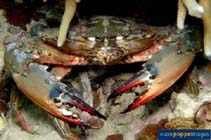Charybdis japonica (Milne-Edwards, 1861)
Japanese swimming crab
Classification / Names Common names | Synonyms | CoL | ITIS | WoRMS
| Decapoda | Portunidae
Environment: milieu / climate zone / depth range / distribution range Ecologie
Benthopelagisch; diepteverspreiding 0 - 50 m (Ref. 125642). Tropical
Verspreiding Landen | FAO regio's | Ecosystems | Voorkomen | Introducties
Western Pacific: from Japan to Malaysia. Subtropical and tropical climates.
Length at first maturity / Size / Gewicht / Leeftijd
Maturity: Lm ? range ? - ? cm Max length : 7.0 cm CW mannelijk/geslacht niet bekend; (Ref. 343)
Korte beschrijving Morfologie
Carapace without transverse ridges behind last anterolateral tooth; frontal teeth acutely triangular; anterolateral all acutely triangular. Posterior border of propodus of legs serrated. Palm with 5sharp spines, longitudinal ridges on palm granulated. Color: carapace white with large greyish patches, tips at anterolateral teeth reddish brown; fingers red and white.
Subtropical and tropical climates (Ref. 343). Found intertidal to subtidal, on substrates ranging from seagrass, mud, sand, to rocks. Occur to depths of 50 meters (Ref. 125642). Also found in tidepools on rocky shores (Ref. 118296). Common in estuaries, in firm or muddy fine sands (Ref. 118295). Generalist scavenger and predator (Ref. 118296). Benthopelagic predator, feeding mainly on benthic bivalves (Lamellibranchia), benthic crustaceans, fishes, and cephalopods (Ref. 117071). Host to the sacculinid barnacle Heterosaccus papillosus (Ref. 118296).
Life cycle and mating behavior Geslachtsrijpheid | Voortplanting | Kuitschieten | Eieren | Fecundity | Larven
Members of the order Decapoda are mostly gonochoric. Mating behavior: Precopulatory courtship ritual is common (through olfactory and tactile cues); usually indirect sperm transfer.
Voornaamste referentie
Referenties | Coördinator | Medewerkers
Ng, P.K.L. 1998. (Ref. 343)
Status op de Rode Lijst van het IUCN (Ref. 130435)
Status bij CITES (Ref. 108899)
Not Evaluated
CMS (Ref. 116361)
Not Evaluated
Gevaarlijk voor mensen
Gebruik door de mens
| FishSource |
Tools
Meer informatie
Populaire namen
Synoniemen
Predators
Voortplanting
Geslachtsrijpheid
Kuitschieten
Fecundity
Eieren
Ontwikkeling van de eieren
Synoniemen
Predators
Voortplanting
Geslachtsrijpheid
Kuitschieten
Fecundity
Eieren
Ontwikkeling van de eieren
Internet-bronnen
BHL | BOLD Systems | CISTI | DiscoverLife | FAO(Publication : search) | Fishipedia | GenBank (genoom, nucleotide) | GloBI | Gomexsi | Google Books | Google Scholar | Google | PubMed | Tree of Life | Wikipedia (ga naar, zoek) | Zoological Record
Estimates based on models
Prijsklasse
(Ref. 80766):
Unknown.



